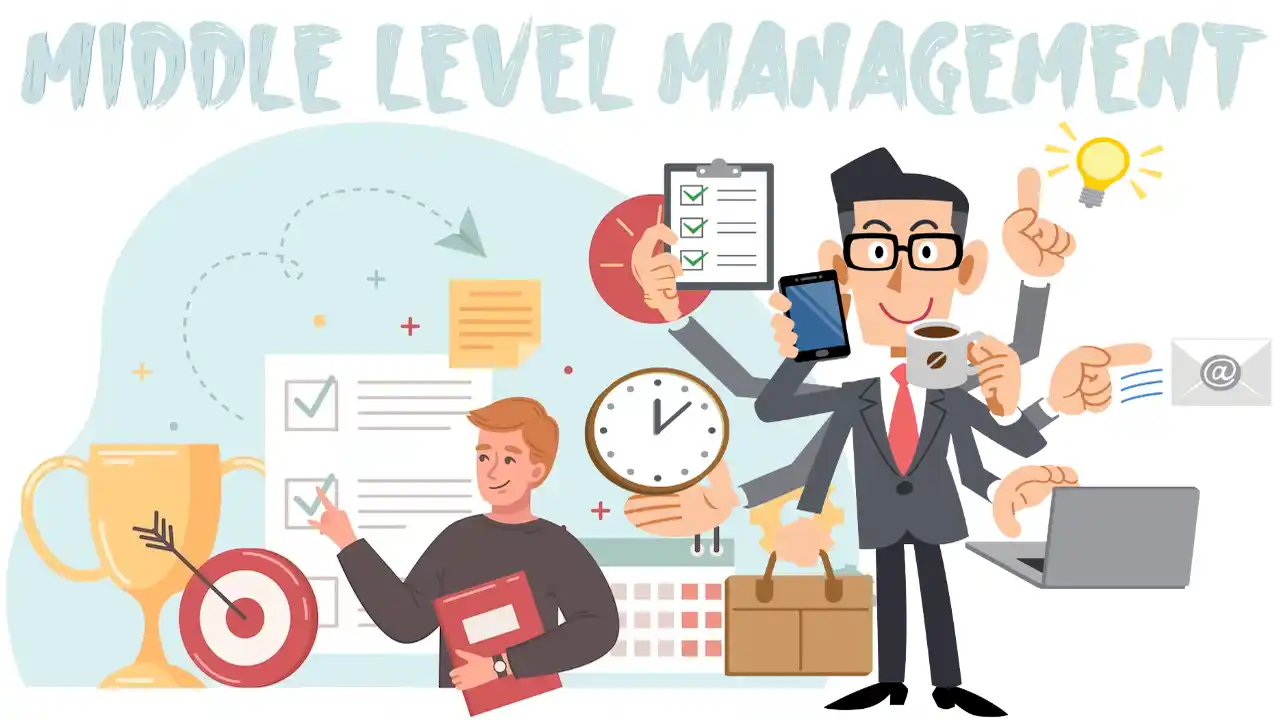Management in the middle of an organization’s structure acts as a link between the top and bottom levels of leadership. They are directly in the middle of the management chain. middle-level management will be covered in-depth in this article, along with various examples for your convenience.
Among the company’s administrative tiers, this one offers the highest salary and the greatest number of perks. Middle managers typically oversee multiple sub-units or locations. Managers in the middle tier of an organization’s management structure are more concerned with strategic oversight and management than they are with day-to-day operations. For a better grasp of types of office management, read more about it.
Middle Level Management
The middle management has the ability to interact with the upper management by providing suggestions and comments. Due to their greater exposure to day-to-day operations, middle managers are in a prime position to provide crucial feedback to upper management that can help shape the company’s long-term strategy.
Managers at the general manager, branch manager, and area director levels are all considered middle-level executives. They spend more time arranging and carrying out work than senior management does, yet they are answerable to them for how their region functions. Before you think about money, investing, business, or managing it, consider the middle level management.
Management of Labor
Managers in the middle tier demand accountability from their subordinate staff. In addition, they commend and recognize those who go above and beyond to accomplish their goals. Middle managers need functional skills or expertise to do their jobs well. A leader in the finance department, for instance, needs to be financially literate.
Communication
Any form of communication with higher or lower-level management is possible. Information might be skewed when people have trouble communicating with one another. When this happens, things like the implementation of organizational plans at lower levels suffer.
Facilitating Teamwork
The company’s goals can only be achieved through cross-departmental cooperation, which is facilitated by middle management. In today’s fast-paced world, cooperation is, along with competition, one of the most influential forces in the growth and change of corporate middle-level management.
Policy Interpretation
Now is the time for the company’s top brass to have their policies interpreted. Employees nod in agreement as the marketing director outlines the company’s sales concept of offering credit at no cost to the consumer.
Communication of Orders
Managers of individual departments provide their staff with direction and guidance. Subordinates have access to all the tools they need to carry out their responsibilities with minimal interference from higher-ups.
Motivation
Middle managers have a lot of people under their supervision, including other managers. They need to be able to inspire their team members to do well for the region beyond what the firm gives (such as compensation and bonuses). This is good middle-level management.
Authority
Functions are under the supervision of the middle management. Take the role of money as an illustration. The finance director is the chief financial officer’s go-to advisor on all financial management matters. Investments, financing, dividend policy, budgeting, and asset management are all examples of possible options. The financial manager is responsible for hiring, firing, and managing the finance team. The financial director has the final say, however, subordinates may be given some discretion.
This two-way dialogue permits middle-level administrators to offer suggestions and receive criticism from higher-ups. The importance of the organization will increase as more people participate in its daily activities. As a result, they have a deeper comprehension of how the company’s lower-level strategy and goals are really accomplished. Because of this, senior management will be able to use the data to further the efficiency of the team.
Responsibilities
Middle managers typically oversee a certain company function or department. They are in charge of their division and are accountable to higher-ups. Furthermore, they act as a bridge between upper and lower management.
There is a greater involvement of middle management in day-to-day activities. The next stage after senior executives develop strategic strategies is to put them into action. Many plans and strategies for the team, including middle managers, are prepared at the department level.
They are accountable for the smooth functioning of the division and the implementation of plans by middle managers and staff. As a result, they spend more time than the executive team on administrative tasks and long-term strategy. This is middle-level management.
Decision-making
Making a decision boils down to choose one course of action out of several possible outcomes. It’s easier to make a choice when you have more options to consider. Those in the middle tiers of management are tasked with making important decisions. Because of this, they need to have good judgment.
Delegation
Middle managers delegate responsibility and decision-making to their subordinates. Managing the work of their subordinates and the functional areas on their own would be challenging and inefficient. This is good middle-level management.
Hiring Personnel
Every department head has staff working under them. Employee selection entails conducting interviews with potential candidates, weighing their qualifications against those of other applicants, and ultimately hiring one candidate over another.
Employee Motivation
Middle managers use a wide range of strategies to inspire their teams to work as efficiently as possible toward the organization’s goals. Motivating your workers with an upbeat message doesn’t need much effort on your part. Complimenting your team members is a simple way to make a big difference in their mood. This is good middle-level management.
Recruitment
Managers want a strong group with the right set of skills and knowledge to help the department reach its goals. Therefore, it’s important for managers in the middle to know how to pick the right people and help them grow. Businesses run the danger of being stuck with unqualified workers if this doesn’t happen.
Leadership
Managers in the middle level are responsible for encouraging their teams to work together, discover areas of agreement, and ultimately succeed. Additionally, they need to promote lower-ranking managers as well. Moreover, a competent leader ensures that their own and their team’s knowledge, abilities, and experience are continually developed and improved.
Creating Structure
Each mid-level manager actively develops a strategy to achieve the company’s goals in their own department. First and foremost, an organization can’t realize its goals without actively establishing a set of rules for how its employees should go about carrying out those obligations. This is another middle-level management.
FAQ
What Is a “Middle Manager”?
Managers in the midst of an organization are constantly under fire from all sides. Furthermore, nobody wants to work with you, from your boss to your coworkers to your pals. As a result, you end up feeling like a victim of everyone else’s misery. Additionally, you have to deal with rival strategies, rival interests, and rival relationships.
What Makes Middle Management so Challenging?
Managers in the midst of an organization are constantly under fire from all sides. Nobody wants to work with you, from your boss to your coworkers to your pals. You end up feeling like a victim of everyone else’s misery. You have to deal with rival strategies, rival interests, and rival relationships.
How about some Case Studies on Managing in the Middle?
Managers in the middle have a unique role to perform in any organization. Moreover, divisional managers (or general managers), departmental managers (or functional managers), and executives or project leads (who focus on teams or projects) all make up the middle management tier.
Summary
Moreover, managers in the middle of an organization’s structure play a crucial role as the main point of contact with the business’s auxiliary service divisions. Additionally, we truly hope you enjoyed this lesson on middle-level management and learned something new.






